Joe Cortright discusses the issues between an I-5 Bridge replacement with a 116-foot clearance and one with a moveable span
Joe Cortright
City Observatory
The Coast Guard has told Oregon and Washington that a new I-5 bridge must have a 178-foot vertical clearance for river navigation – vastly higher than the 116-foot clearance the state’s have proposed.

A fixed span with that clearance would be prohibitively expensive and would have to be huge – nearly two miles long, and would have steep grades.
An easier solution would be a new bridge with a moveable span, such as that built for I-95 in Washington DC, yet IBR officials tell falsely claim an I-5 liftwapan would have to be “the world’s largest”
Three Portland area bridges have bascule spans of comparable size to that needed for the I-5 bridge, and much larger bascule and vertical lift bridges have been built elsewhere.
Our story so far: For the past three years the Oregon and Washington Departments of Transportation have been trying to revive their plans for the failed Columbia River Crossing, a massive freeway expansion project between Portland and Vancouver. The project would require replacing the existing I-5 bridges over the Columbia River, and the height of these bridges will be determined by the US Coast Guard. In June, the Coast Guard issued its “Preliminary Navigation Clearance Determination” (PNCD) saying that the bridges would have to at least preserve the current navigational clearances (178 of vertical space. That immediately threw a wrench into the DOT plans to build a fixed span with just 116 feet of clearance. The Coast Guard declared unequivocally:
“Our PNCD concluded that the current proposed bridge with 116 feet VNC [vertical navigation clearance], as depicted in the NOPN [Navigation Only Public Notice], would create an unreasonable obstruction to navigation for vessels with a VNC greater than 116 feet and in fact would completely obstruct navigation for such vessels for the service life of the bridge which is approximately 100 years or longer.’’ – B.J. Harris, US Coast Guard, to FHWA, June 17, 2022
The Interstate Bridge Replacement Project team is hoping to get the Coast Guard to back down, in part by asserting that it would be impossible to build a lift span to provide the Coast Guard’s requirements.
IBR Administrator Greg Johnson testified to the Joint Oregon-Washington I-5 Bridge Committee, that if the Coast Guard required the I-5 bridge to be built with a lift span, it would be the largest such structure in the world.
Here’s a transcript of that meeting, from approximately minute 18 of the audio-video recording created by the Oregon Legislature. Johnson describes the impact on the project of going to a lift span:
“. . . a cost of putting what would in essence be the largest lift span in the world. We’re talking about an additional $400 million in that way. So, these are the trade-offs that we have to look at the viability of a lift span that large which has never been operated at that size before.’’
That’s simply not true. In fact, there are other lift spans in the Portland area that are as large, or larger, than would be needed to include a lift span on the I-5 bridges, as we document below.
But Administrator Johnson’s claim is both ominous and vague. How large would the navigation opening in a lift span need to be? That determination will be made by the US Coast Guard. The current bridge has a vertical navigation clearance of 178 feet. The 2012 Navigation Impact Report prepared for the Columbia River Crossing documented the existing navigation clearances of the I-5 bridges, which are 178 feet vertically and 263 feet horizontally. The bridge also has a barge navigation channel with a maximum horizontal clearance of 511 feet, but this barge channel has a vertical clearance of 46-70 feet. The Coast Guard’s preliminary navigation report said that a new bridge should at least preserve both of the current horizontal and vertical clearances.
Needed Navigation Clearances: 178 feet high, 263 feet wide
Here’s the text of the Columbia River Crossing’s navigation report, showing existing bridge clearances. Keeping the existing main shipping channel, shown on the left, would require a vertical clearance of 178 feet and a horizontal clearance of 263 feet. The Army Corps of Engineers authorized navigation channel under the I-5 bridge is 300 feet wide, but the actual horizontal clearance under the bridge is 263 feet. .
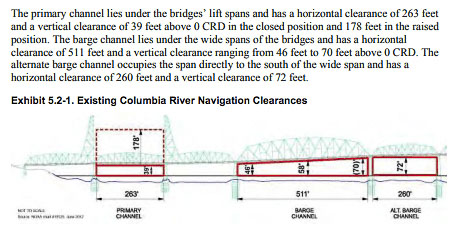
In addition, maximum river channel on this stretch of the Columbia River is already constrained by the next downstream bridge, which is the Burlington Northern “9.6” bridge (less than a mile West of the I-5 bridges). This railroad bridge has a swing span with an opening width of about 230 feet. In order to provide a 263 foot wide channel, the I-5 bridge would need two bascule leaves with a length of 135 feet each.
One does not have to look far in the Portland Metro area to find such bridges. There are three in the center of downtown Portland, the Morrison Bridge and the Burnside Bridge. The Morrison Bridge (1958) has two bascule lift sections, with an opening of 284 feet. The Burnside Bridge (1926) also has two bascule lift sections, with an opening of 252 feet. The Broadway Bridge (1911-12)–a slightly different kind of bascule–has an opening of 278 feet.
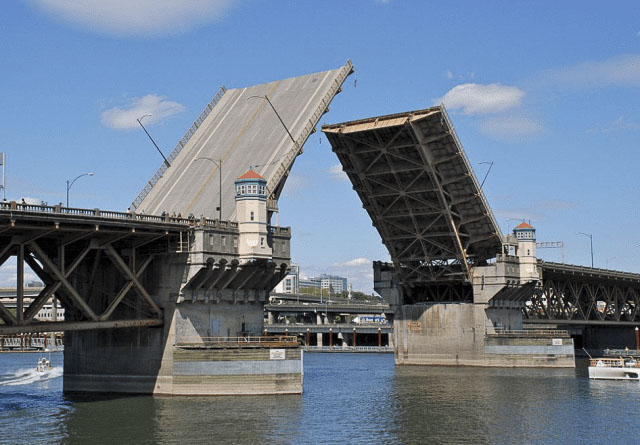
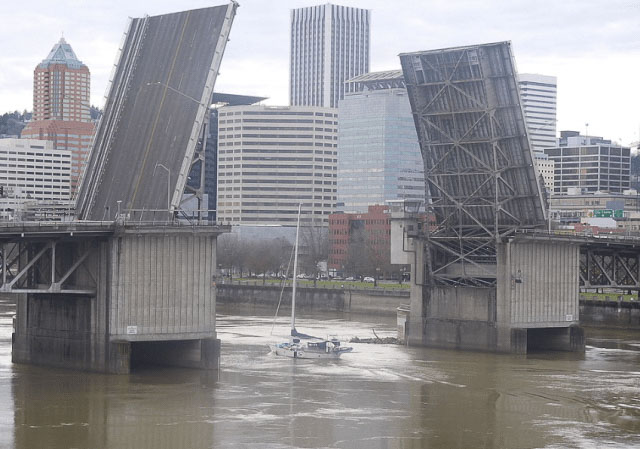
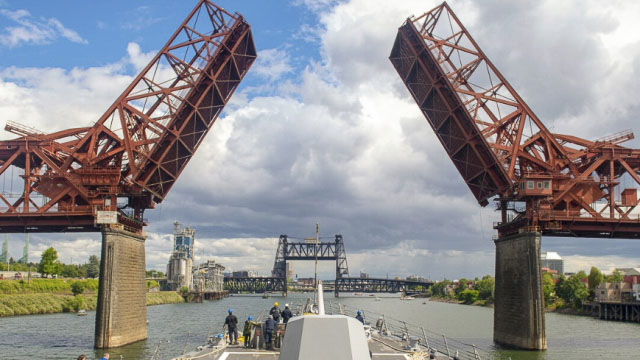
Nor is the width of the needed roadway an obstacle. The Morrison Bridge has a roadway width of 90 feet — exactly the same as the width proposed for each of the two aborted Columbia River Crossing bridges.
Woodrow Wilson Bridge: A modern busy Interstate with a lift-span
But can we have lift spans on Interstate highways? Actually, the answer is yes. I-95, the one of the nation’s busiest freeways connecting the major metro areas on the East Coast, has a lift span in Washington DC. The Woodrow Wilson Bridge, opened in 2009, has a modern double leaf bascule bridge that carries 12 travel lanes and 250,000 vehicles per day across the Potomac River. Also, there’s some question about the width of the roadway on the bascule bridge. For the record, the Woodrow Wilson Bridge has two separate sets of “leaves” for the north and south bound sections of I-5 (i.e. it’s like two bascule bridges side by side).
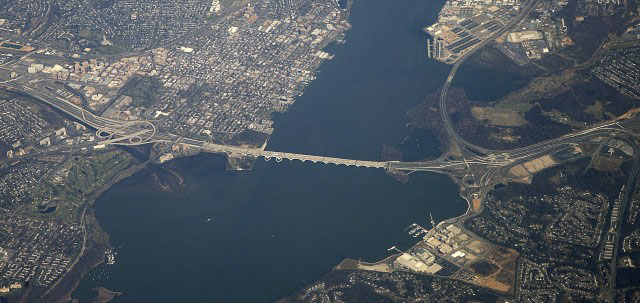
The Woodrow Wilson Bridge allows for a relatively low level crossing of the Potomac River, minimizing the height and footprint of interchanges on either side of the river (shown above).
Rather than towering over the Vancouver waterfront, and requiring lengthy elevated roadway sections across downtown Vancouver and over Hayden Island, a bascule lift-span bridge could be built at a much lower level, eliminating the need to rebuild intersections high into the air to meet a fixed span high enough to clear 178 feet.
In contrast, a fixed-span high-level bridge violates both the pledges to respect the environment and promote equity. It hurts the environment, because the high bridge requires vehicles to climb over a much higher elevation, leading them to consume more fuel and emit more pollutants than would be the case with a lower elevation lift-span crossing. This is especially true for heavy trucks that will struggle to climb the high bridge’s steep grades, and which will create a safety hazard for faster moving cars. The high bridge is also inequitable for those who are not traveling by car: those who walk on bike or on foot will find the steep grades associated with the high bridge much more taxing than the motorists, who will simply have to press harder on the accelerator pedal.
Not the world’s largest lift bridge
Contrary to what IBR staff imply, there’s nothing unusual about the size of the possible lift-span for the I-5 bridge. Large bascule bridges are not uncommon. The Rethe bridge in Hamburg Germany, built in in 2016, has an opening of about 308 feet. The Erie Avenue Bridge in Lorain, Ohio, built in 1940, has an opening width of 330 feet. The Market Street Bridge in Chattanooga, has an opening that is 358 feet wide.
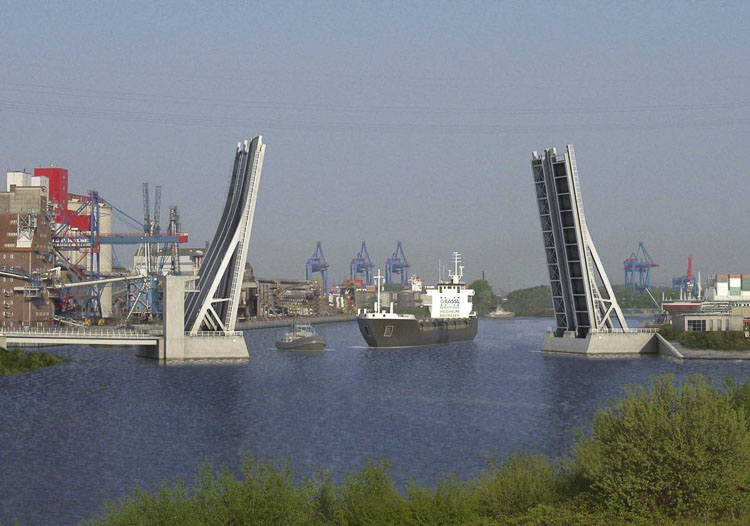
An I-5 lift span meeting the Coast Guard’s requirements would not only not be the largest lift-span in the world; it wouldn’t be even the largest lift span in the neighborhood That particular honor belongs to the Burlington Northern Willamette River Bridge 5.9, which has a vertical clearance of over 200 feet, and a moveable span that is more than 500 feet long – higher, and almost twice as wide as the needed opening for a new I-5 moveable span meeting Coast Guard requirements.
The Burlington Northern Willamette River Bridge: 200 feet high, 500 foot opening.
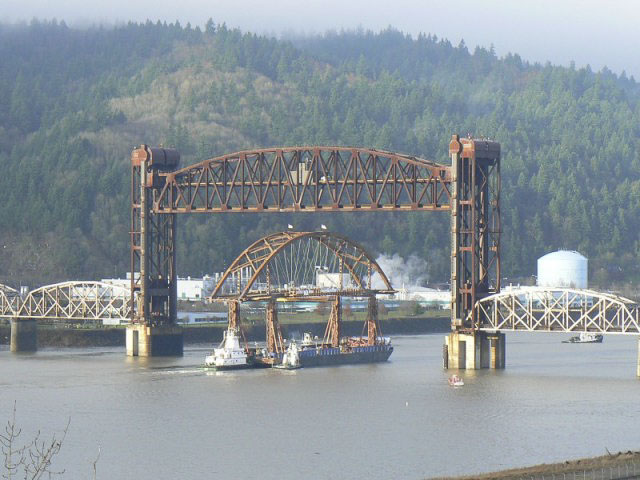
This lift span was paid for by the federal government in 1989 and has a lift span that is 516 feet long and it provides a vertical clearance of 200 feet. The lift span was added to the existing bridge in place of a swing span for a cost of less than $40 million (about $125 million in today’s construction expense). Photo courtesy Wikipedia
Repeating Past Mistakes: Planning a bridge too low
A decade ago, the Oregon and Washington Transportation Departments tried to force the Coast Guard to agree to a fixed Columbia River Crossing I-5 bridge with a height of just 95 feet over the river, arguing (exactly as they are now) that this lower level best balances the needs of different forms of transportation. Balancing needs of road users, though, is not the legal standard applied by the Coast Guard, which following federal law, prioritizes the needs of river navigation. As the Coast Guard said in its review, road users have many alternate routes for crossing the Columbia River; waterborne commerce has none.
The two DOTs attempting to force the Coast Guard to agree to a lower bridge height added more than a year of delays to the CRC process (which ultimately failed) as well as millions of dollars in added planning costs. The IBR team has no plans to seek a bridge permit before 2025, and thereby seems intent on repeating this mistake – moving forward with attempts to convince the Coast Guard to approve a lower navigation clearance, while spending tens of millions of dollars planning a bridge that may not meet the Coast Guard’s legal requirements.
Also read:
- Opinion: Neighbors for a Better Crossing calls for a current seismic study for $7.5 Billion Interstate Bridge projectNeighbors for a Better Crossing is urging a new seismic study before construction proceeds on the $7.5 billion IBR project, raising transparency concerns and proposing an immersed tube tunnel alternative.
- Rep. John Ley supports C-TRAN Bus Rapid Transit to save Washington moneyRep. John Ley praised C-TRAN’s new BRT line as a faster, lower-cost alternative to light rail, urging support for transit options that save taxpayers money and improve service.
- C-TRAN, WSU Vancouver celebrates groundbreaking for The Vine on Highway 99C-TRAN and WSU Vancouver broke ground on the Vine’s Highway 99 route, a 9-mile bus rapid transit line connecting the university to downtown Vancouver and the Waterfront, set to open in 2027.
- C-TRAN board again postpones vote on light rail operations and maintenance costsThe C-TRAN board again postponed a vote on language regarding operations and maintenance costs tied to light rail expansion, with pending lawsuits involving Michelle Belkot continuing to impact board actions.
- Opinion: ‘The Interstate Bridge project lacks billions in funding from both Oregon and Washington’Lars Larson criticizes Oregon’s funding decisions, highlighting the billions missing from both states for the Interstate Bridge replacement project and calling it a dead-end effort lacking Coast Guard approval.










Tunnel = best solution? Seems to solve every problem.